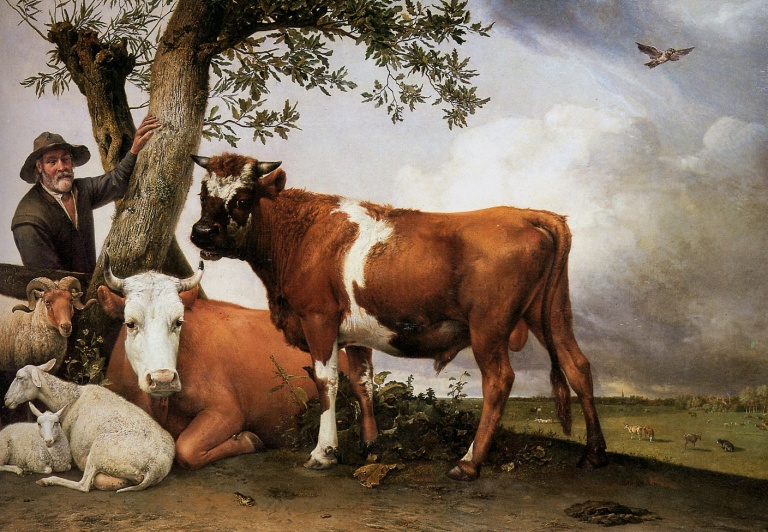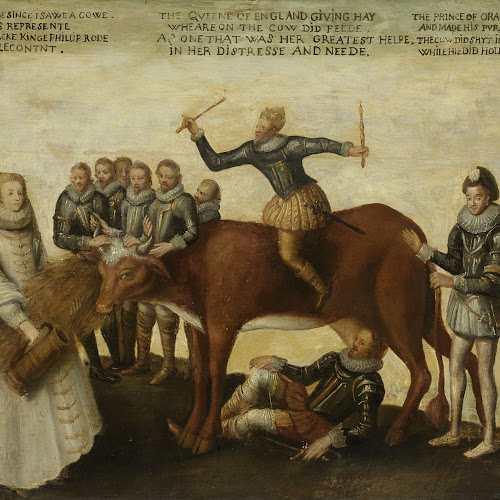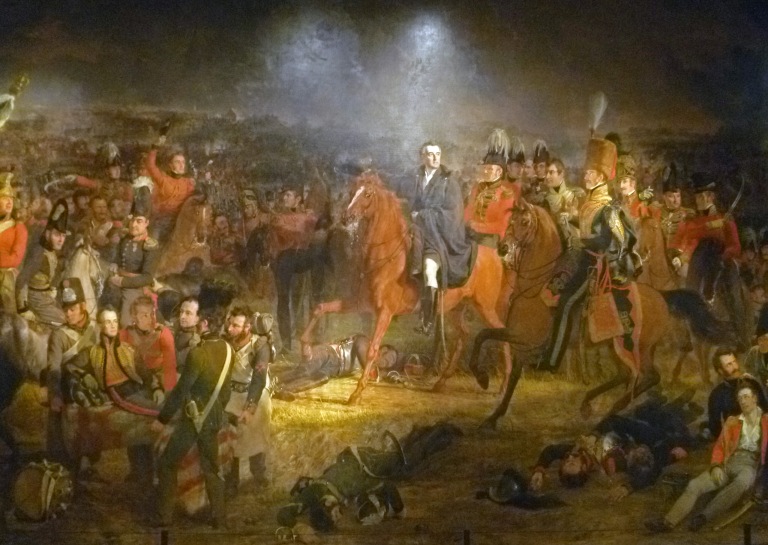 Paulos Porter The Bull, 1647. Oil on canvas, 7’5″ x 11′. Mauritshuis, the Hague.
Paulos Porter The Bull, 1647. Oil on canvas, 7’5″ x 11′. Mauritshuis, the Hague.
Westermann argues that the animals depicted in the Bull of 1647 are representative of Dutch pride because of the booming dairy and cattle breeding industries of the time (Westermann 108). She goes on to say cows depicted in this time period could be representative of the Dutch Republic itself. She offers very little evidence to support this claim aside from saying that cows had become a source of national pride. Westermann goes on to highlight the inscription on an etching by Hendrick Hondius II commissioned three years earlier: “so that the Dutch cow shall not be stolen from us.”
This seems to contradict the claim that the cow represents the Republic; why would Hondius II not simply have inscribed “so that the Republic shall not be stolen from us” if his cows were meant to represent the Republic? I contend that cows are depicted in a much more literal manner than Westermann asserts. The depiction of the cow is likely representative of the Dutch economy because of their central economic role in the Dutch Republic. It is also likely that the cow is simply drawn and painted in many pieces of art because they were common throughout the Republic.
It is important to note that while the cow might not solely depict the Republic, it plays a large part in its overall depiction. In Albert Cuyp’s View of Nijmegen with the Valkhof, two men sit and one stands next to two cows (or possibly bulls) across the river from the Valkhof (a foritifcation known as the falcon court). Historians viewed, “Nijmegen as the seat of Claudius Civilis and bulwark of Charlemagne and the Republic” (Westermann 102). This bulwark of the Republic would be incomplete without a cow resting. I believe that cattle and the Republic were connected, both in reality and artistically, in the same way the Kingdom of Saudi Arabia is connected to oil. Although the cow is not a depiction of the Republic itself, it is nonetheless a critical part of the Republic and therefor was used extensively in artwork during this period.

The milk cow: satire on the exploitation of the Netherlands by the Prince of Orange, anonymous, c. 1633 – c. 1639. Oil on panel 52 cm x 67 cm.
This painting stuck out to me when scrolling through the archives because it is so unlike the others. It is not photorealistic and is satirical in nature. I also am interested in learning more about what the milk cow means in this painting. Could it be that Westermann was correct in arguing that the cow depicts the Republic as a whole? Or does it simply mean financial domination by the Prince of Orange? I’ll need to do some research to answer these questions before I arrive at the museum.

The Battle of Waterloo, Jan Willem Pieneman, 1824. Oil on canvas. 567cm x 823cm.
I love giant paintings like this as well as depictions of famous battles. The large paintings of scenes from the Revolutionary War and George Washington’s life throughout the US Capitol are among my favorites. Waterloo was a monumental moment in history because it ended Napoleon’s conquest of Europe. Napoleon, despite being ruthless, was a remarkable man and one of the most skilled military practitioners in human history. I look forward to seeing this painting in person.
I found it interesting (and comical) that cows are thought to symbolize so much Dutch art. I never really thought of them as too important of an animal, I would think that horses might symbolize more than cows especially in military paintings. I would be curious to know why only four men are on horses in The Battle of Waterloo by Jan Willem Pieneman; what do they symbolize?
LikeLike
I found the description of the cow as a symbol of the republic to be very decisive choice for the artist and interesting thing that Westermann picked up and that Adain decided to write about. The cow was definitely a way for people during this time to make a living through use of grazing, making leather, selling, trading goods, or even selling their milk. In other words, they were certainly important for the Dutch during the time this painting was made.
I think Adain could expand on his idea concerning the satire painting of the cow I am also curious about the satire painting of the cow and how that one is different from the painting above but may still have a similar meaning.
LikeLike
Nice to question evidence for broad assertions! I wonder if perhaps it depends on what we mean by “symbol”? Some symbols are literally that–iconic representations that are widely held to represent a specific idea. For example (as I think Westermann points out), oysters were widely understood by 17th century Dutch painters and viewers to represent sex. Sooo…. there’s that. Others may be symbolic in much weaker ways: a fine cow representing generally the idea of quality animal husbandry and maybe pride of the breeder. So yes, maybe a cow is just a cow! But what a cow– particularly robust and fecund/virile cows/bulls may represent a host of ideas, whether vaguely (the economy, masculinity, fertility, good farming) or specifically (if indeed cows became iconic representations of the Dutch republic–but again, we’d want evidence that this had become the case. Maybe we need better terminology than “symbol” to describe what kinds of relationships we see between the represented thing and an idea it might (or might not) represent.
LikeLike
Hi Aidan! I think you make a great point that cows might not necessarily be a grand symbol of Dutch pride—they could definitely represent the cattle industry and economic success, or maybe the cows are just cows that are there because they were so ubiquitous in the countryside that artists naturally included them. I think in The Bull and the Hondius etching, the cows are probably more symbols of a really successful industry, and I think that could be really strongly tied to a sense of national pride, but I think that also depends on who’s looking at it and how they themselves feel about cows and the Netherlands.
LikeLike
I think Joe makes an interesting point, that maybe a cow is just a cow – part of a natural landscape. However, it does seem as though cows were used as status symbols and to show off prosperity. Looking at the way cattle were depicted during the Dutch Golden age — well fed, strong, and calm — it seems as though they served a crucial role in Dutch society. It seems as though the Dutch integrated healthy livestock into their paintings, to show off a “full” and thriving economy, especially interesting. It definitely does not look like the Dutch suffered from famine or economic depression when there are pleasantly plump cattle grazing the vast landscapes.
LikeLike